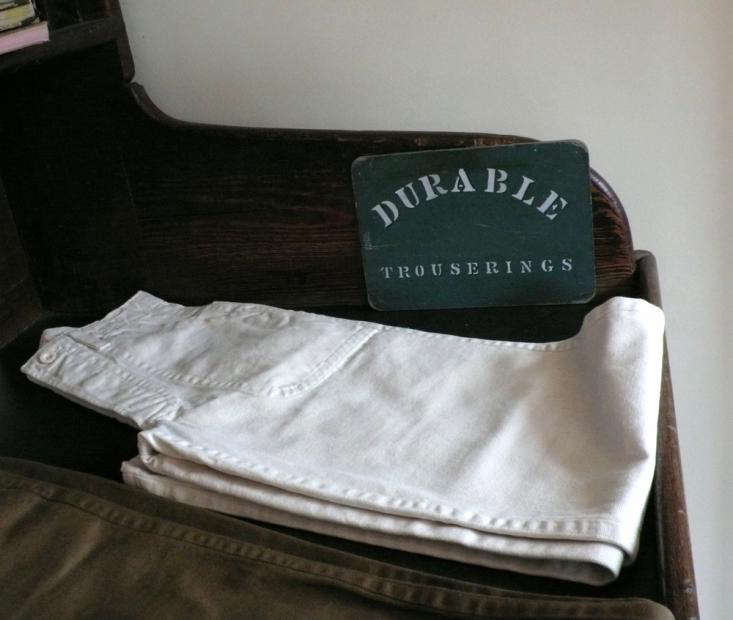When we ran a post last summer on The Carrier Company‘s gardening smocks, there was some incredulity in the comments section. Gardening in a smock? Were we mad? Personally, I’d always choose loose clothing when working outdoors and have a uniform of aertex shirt and canvas trousers with knee enforcements. Waxed cotton coat if it’s wet or cold. It’s very difficult to wear anything else. Cotton, canvas, oilcloth: they let the air circulate and keep off the wind and showers. In a downpour? Stand under a tree.
Photographs by Kendra Wilson, except where noted.

Above: This could be the ultimate British garment. An oilskin top, worn for almost 365 days of the year, gardening optional. It’s the Top 64 from drapers Merchant & Mills: “More than a jumper, less than a jacket.” And for doubters, it is based on a fisherman’s top. For pricing and more information, see Merchant & Mills.

Above: Old Town in Holt, Norfolk, specializes in traditional work wear, and counts several head gardeners among its clientele. Large-scale gardening is more reliant these days on machinery but that is no reason for less durable trouserings.
For US readers, Carhartt’s “Made in the USA” line is a source of no-nonsense work wear (with knee reinforcements).

Above: The Orford trouser made of canvas; £110 from Old Town. Also popular are two weights of cotton drill for trousers, jackets, waistcoats, skirts, and housecoats: medium weight drill and stout twill.

Above: A fleece is cozy but gets soggy in the rain. A rubber-lined kagool is clammy. Merchant & Mills in Rye, Sussex, have been sourcing traditional cloths for years and specialize in British oilskin. “Antiqued oilskin ages well,” says Carolyn Denham, the sewing half of Merchant & Mills. Unlike the standard version (used for the iconic Barbour label), antiqued oilskin is less oily and can be washed, while retaining its water resistance. Duck canvas is also waterproof, as is gabardine.
Tweed and worsted wool lead the way in winter, for naturally repelling moisture while being incredibly hard-wearing. The latter is more refined and made to be practical: “You’ll be rolling down hills in it for years,” says Carolyn Denham. Image via Merchant & Mills.

Above: In humid weather, which we happen to be experiencing right now in the UK, I would want to grab something designed to keep Englishmen cool in the tropics, or on the school playing fields. Aertex.
Due to the demand for ultra-cheap polo shirts, production of traditionally woven cellular cloth (made by Aertex) has ceased. The clever people at Old Town have bought up the last stocks and are able to make up a shirt for you in a choice of colors: eau de nil, navy, black and white, though hurry with white as it is running low. The reasonably priced clothes are made to individual specifications above the shop.

Above: Old Town’s Ida Smock is loose-fitting with a Peter Pan collar, made from shirt weight drill (£85). For US readers, drill cotton shirts and trousers are available from Post Overalls.

Above: At last, a hat for rain and sun; not too big, not too small, it’s reminiscent of Christopher Robin. Known as The Selsey, this cotton canvas hat is £40 from Old Town.

Above: It may be worth mentioning here that Merchant and Mills do not sell ready-made clothes, being a draper. They sell patterns and cloth plus other “notions.” They will not be persuaded to make up clothes for you, but the patterns are very simple. “We don’t want people to look like they’re wearing homemade clothes,” says Carolyn. “Believe me,” she continues. “No matter how badly you sew, when you make up a pattern it will look like the sample in the shop.”
(The Top No.64 Pattern is £20, requiring two meters of cloth, antiqued oilcloth being £20 per meter).
Bear in mind: nobody will judge you if you give the fabric and pattern to a dressmaker.
And yes, we’re still mad for smocks. To read more about our favorites, see The Well-Dressed Gardener.












Have a Question or Comment About This Post?
Join the conversation (5)